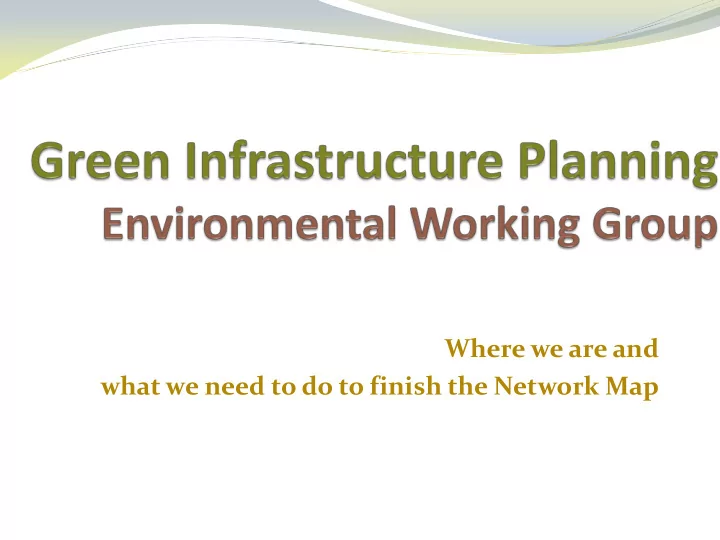

Where we are and what we need to do to finish the Network Map
Green Infrastructure Planning Disciplinary Foundations
Green Infrastructure Planning Planning Elements - General Leadership Forum Provides science-based process Identifies key partners for collaboration Network Design Incorporates conservation science Expresses data needed to achieve goals Promotes pro-active, systematic, large-scale conservation action Implementation Quilt Allows for cooperation among diverse programs and projects Provides possibility of greater predictability and certainty for development & conservation
Green Infrastructure Planning Planning Elements – Our Version Leadership Forum Executive Group, Resource Team, Working Groups, & the Public Network Design – Environmental focus Urban Forestry Conservation Assessment Working Group maps Implementation Quilt We’re setting things up for this
Green Infrastructure Planning Project Planning - General Goals – specific statements of project intent Objectives – quantifiable methods for implementing goals (what, how much, and by when) Scale & extent – study area definition Planning outcomes – likely elements in long-term Implementation Quilt Landscape types – provide rationale for deciding what resource attributes or features to include and connect within Green Infrastructure Network Landscape attributes – provide direction re: data needed
Green Infrastructure Planning Project Planning – Our Version Goals - develop a strategic conservation planning tool Objectives – create a Green Infrastructure Network map that will serve as a planning tool for the study area planning agencies, conservation efforts, and developers & builders, and increase public awareness of the ecosystem value of Green Infrastructure Scale & Extent - Planning area boundaries of Farmington, Fayetteville, Greenland, Johnson and parts of Washington Co. over to Wedington Wildlife Mgmt Area Planning Outcomes – Network Map and online map server will highlight and guide many possible patches for Implementation Quilt Landscape Types – forested areas, prairie remnants, heritage & cultural sites, parks & trails Landscape Attributes - provided by YOU (the Working Groups) and the Urban Forestry Conservation Assessment (UFCA)
Green Infrastructure Planning How Planning Design interfaces with GIS Processes & Network Map development Leadership Forum Provides guidance for GIS parameters Network Design Develop cores, hubs, and corridors Integrate data and Leadership Forum guidelines Core/hub minimum size based on ecological principles Corridor minimum width based on ecological principles Network characterization and prioritization possibilities Provide ecological value weighting (as in UFCA) Provide vulnerability ranking (ex: development pressure) Implementation Quilt Suitability Analysis can point out priority action areas Refines usefulness of network (ex: shortfalls & restoration targeting) Subjective but not arbitrary
Green Infrastructure Network Map element priorities for Habitat preservation We design GI networks to mitigate or minimize habitat loss or fragmentation impacts. The more fragmented the habitat, the more important corridors become. From: Green Infrastructure GIS Tools for Strategic Conservation Planning, 2009
Green Infrastructure Planning Idealized Network Map
Green Infrastructure Planning Network Element definitions Cores Fully functional natural ecosystems – based on needs of an interior dwelling ‘umbrella’ species High quality habitat for native species Nucleus of Network Hubs Slightly fragmented aggregations of core areas plus contiguous natural cover Large enough to support populations of native species and serve as sources for emigration into surrounding landscapes Corridors Linear links between cores/hubs that allow passage of animals, seeds, pollen, etc. Best functioning corridors are wide enough for interior conditions and species
Here’s what we have for Upland Forest
Here’s what we have for Prairie remnants/grasslands/wetlands
Here’s what we have for Hydrologic Elements
Here’s what we have for UFCA Tiered Top 100 Terrestrial & Aquatic
Here’s what we have for UFCA Aquatic parcels ranked 1-3 of 1-10 1468/9417 = 15.5%
Here’s what we have for UFCA Terrestrial parcels ranked 1-3 of 1-10 413/2986 = 14.4%
Here’s what we have for UFCA Terrestrial & Aquatic parcels ranked 1-3 of 1-10 overlaid Colors indicate overlap of T & A classes Red 1 & 1 Orange 1 & 2 Purple 1 & 3 Yellow 2 & 2 Green 2 & 3 Blue 3 & 3
Here’s what we have Karst Area Sensitivity Map
What we need to do Consult our experts about interior dwelling ‘umbrella’ species Decide if species parameters apply to all 4 of our network inputs: Upland forest, Prairie/Grassland, Hydrology, UFCA & KASM. Decide on minimum core sizes and corridor widths for the network inputs where species parameters do apply. If species parameters don’t apply, decide what physical parameters do.
Let’s talk about… How do we want to do this: Split into Sub-Committees and decide right now? Take it home and think about it for another meeting? Adjourn to the pub for a Symposium? Who should make decisions about adapting the UFCA? Perhaps Upland forest decisions should apply.
Recommend
More recommend